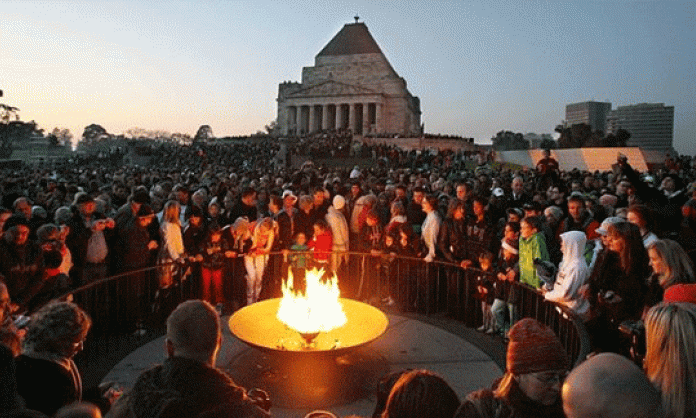As the nightmare of the Great War subsided, the horrors of the peace replaced it.
So many bore terrible physical and mental wounds; the press called these the price of victory. Many others bore terrible economic wounds.
Our rulers rushed to create diversions before the anger against them boiled over. They held out the hope of a land “fit for heroes”, in which 9,000 in NSW alone were encouraged to go bush. These adventures took the form of special farming schemes for veterans. They were allotted small and marginal blocks of land.
This catered to popular notions that life on farms was happy and healthy. It also appealed to workers’ forlorn hopes of being “their own boss”. The authorities gave little heed to environmental dangers such as salinity. They were indifferent to the fate of the Aborigines already scratching a living on the fringes of these areas and now displaced again. But there was no way for them to ignore the financial crisis that soon afflicted many returned diggers.
The veterans wrote angry and eloquent letters. Arthur Calwell of Balranald told the NSW Lands Department: “Before taking up this property I myself owed no man a shilling … Today I’m practically insolvent, ashamed to walk down the street.” George Mathews wrote from Dubbo that he “had to walk off the place with nothing, and now you ask for payments”.
Local authorities squawked that several of these amateur farmers displayed “Bolshevik tendencies” – after the farmers had done nothing more than form an association in NSW. Few settlers actually took radical steps, even when the government seized their cows. Some stayed and suffered, some walked off the land.
However the soldier-settlers went at it, these schemes couldn’t contain the problems of a traumatised generation.
Unionists resisted in Fremantle and Townsville. They drove out scabs in a mobilisation by much of the population of Fremantle, led by returned soldiers familiar with bayonets. One wharfie was killed, but police, the premier and the scabs were driven out of Fremantle. As historian Bobbie Oliver relates in War and Peace in Western Australia:
“The crowd soon swelled to about 1,000 men, women and children, including several returned soldiers in uniform. The battle for possession of the wharf went on for over an hour, by which time the crowd had increased to three or four times its previous size … For the next few days, Fremantle was for all intents and purposes controlled by the lumpers [dockers]. Twenty-six police and seven lumpers had been injured …
“[A] series of riots involving returned soldiers and lumpers rocked Fremantle … a large crowd, several thousand strong, gathered between the Federal Hotel and the post office. Two constables had been set upon in High Street. The armed officers who went to their aid were also attacked.”
In Townsville during a bitter 1919 strike, writes Terrence Cutler, “300 men appeared at the yards armed with sticks and palings. They tore down the gates, drove the cattle out, cut up saddles and poisoned the drinking water.” After the police arrested prominent union leaders, and when workers marched to the lock-up demanding their release, the police opened fire.
“When several constables attempted to mingle with the crowd to note proceedings they were mobbed, and forced to take refuge in the bank … The main street of Townsville was in the possession of the meaties and their allies.”
As Mick Armstrong notes, “the police were forced to release union organiser Pierce Carney. The Queensland Labor government rushed police reinforcements to Townsville by rail to restore ‘order’.”
The birth of Anzac Day
But from 1916, the seeds of another evil tradition were sprouting: an ideological way to promote war in the guise of helping servicemen. 25 April was officially named Anzac Day. Australian troops marched in London, and a sports day was held in the Australian camp in Egypt. In the Sydney march, vehicles carried wounded soldiers from Gallipoli attended by nurses.
It sounded benign and reeked of evil. “For the remaining years of the war”, writes the Australian War Memorial, “Anzac Day was used as an occasion for patriotic rallies and recruiting campaigns”. In other words, to gather cannon fodder.
The ALP should have opposed this trend; after all, it claimed the mantle of anti-war party. Yet its political line contained deep contradictions, vacillating between defence and “anti-militarism”. The same ALP-aligned Brisbane Daily Standard that declared “Labor abhors war” also insisted that war was a fact that “must be faced” and workers must be mobilised for it. It got worse. According to the Westralian Worker, the official organ of the WA ALP, it was “supreme folly” to talk of peace.
This hypocrisy resulted from the nationalism that replaced so much of its initial socialism. For this, Labor bears a terrible responsibility. “The Labor Party is synonymous with ‘Australian’”, said the Tocsin in Melbourne. Indeed, Labor set the nationalist pace. Labor declared the day’s official status and told of how the “world marvelled at the men of Anzac”.
Based on this jingoistic stance, most Laborites could drift into an uneasy but persistent relationship with the key Anzac organisation, the RSL. Because the latter had up to 150,000 members at the end of the war, around 80 percent of them workers, Labor and the unions couldn’t afford to ignore it, especially with some veterans returning from the war with their former industrial loyalties weakened.
Complaints in the ’20s that Anzac Day had been “hijacked” by the conservatives were futile. Labor had helped the process.
Resistance to militarism
Not that there was no opposition.
Australian forces were dramatically affected by mass soldiers’ revolts across Europe in 1918. The troops held meetings, then found ways to disrupt parades. More than 100 were punished. But none launched measures comparable to the Fremantle and Townsville riots of 1919.
Back home, the Communists didn’t shrink. The Communist paper Workers’ Weekly argued for workers to oppose the commemoration by attending May Day and other workers’ celebrations instead. It published a letter from a “Class-Conscious Digger” in 1928, who declared:
“April 25 has become a day of imperial boasting and military boosting … On Anzac Day, capitalists, politicians and priests will don their silk hats and decorations and come out and chant about Anzac in order to build up a new military tradition in Australia, to get ready new Anzacs for recruiting, to prepare young Australia for another bloody massacre.”
Well said, but there were too few of these.
Similar problems returned during the Second World War. The country’s most celebrated anti-militarist, John Curtin, insisted: “We are the Anzac breed. Our men stormed Gallipoli, they were the rats of Tobruk.” Here was the famed anti-conscriptionist implementing conscription. Most workers thought this a military necessity to repel a Japanese invasion. Curtin, who had access to broken Japanese codes, knew there was no such threat.
There was resistance to the Anzac nonsense even in the right wing atmosphere of the 1950s. Provoked by an RSL campaign against the Communist Party, student journalist Geoffrey Haveers attacked the “yearly pageant of national necrophilia” and attracted surprisingly little complaint. Alan Seymour followed with his 1958 anti-Anzac play, The One Day of the Year. In this way, the intellectual left opened the way for a much more radical critique of militarism in the 1960s.
During the Vietnam War, protesters managed to paint P-E-A-C-E across the front of the Melbourne shrine. In the war’s aftermath, a significant minority began to consider the offensive foolishness of telling the world that the Anzacs fought for “freedom” when the Gallipoli fiasco was obviously an indefensible invasion of Turkey.
On 26 January 1988, Australia’s “Celebration of a Nation”, marking two centuries of white Australia, ended in a debacle. Demonstrations by Indigenous people and their supporters finally branded Australia Day with its fitting and enduring title: Invasion Day. Chastened white patriots had to beat a retreat, and their thinking focused now on turning Anzac Day into the preeminent day of nationalist celebration.
Yet Anzac Day faced a demographic threat. As service personnel gradually died off, the numbers marching declined; singer Eric Bogle’s lyrics haunted the RSL: “The band plays Waltzing Matilda, and the old men still answer the call.
But as year follows year, more old men disappear. Someday no one will march there at all.”
The day has revived, based on its government funding and family appeal, replete with religious claptrap and vintage cars. It’s probably easier to sell all this “Anzackery” to well-meaning families than it was to sombre old diggers who knew the reality of war.
Today, new ideological battles are arising. Prominent historians have unsettled conservatives with a challenging 2010 book called What’s wrong with Anzac, while Peter Stanley, the former senior historian at the Australian War Memorial, has led the foundation of online information source HonestHistory.net.au.
The Victorian Society for the Study of Labour History held a conference this year called “Fighting against war”, while historian Robert Bollard has brought a new focus on class analysis in his In the shadow of Gallipoli.











